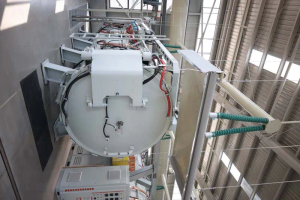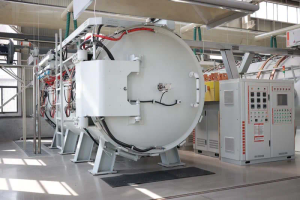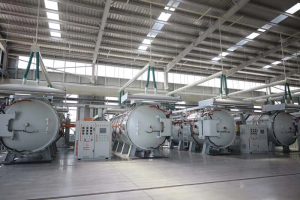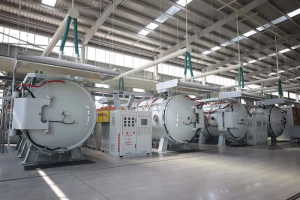The Crystal Structure of Silicon Carbide- Understanding Its Strength
The Crystal Structure of Silicon Carbide: Understanding Its Strength
Silicon carbide (SiC) is a notable material in the realm of advanced ceramics and semiconductor technology, renowned for its remarkable properties, including its exceptional hardness, thermal conductivity, and chemical stability. To fully grasp why silicon carbide possesses these extraordinary characteristics, it is essential to delve into its crystal structure. This article explores the intricate details of silicon carbide’s crystal structure and how it contributes to the material’s strength and other properties.
Silicon carbide is a compound consisting of silicon and carbon atoms in a 1:1 ratio. The material is composed of a covalently bonded network of silicon and carbon atoms, forming a crystal lattice. This lattice structure is primarily responsible for the material’s outstanding mechanical and thermal properties.
The Crystal Structure of Silicon Carbide
Silicon carbide can crystallize in several different forms, or polytypes, each with unique arrangements of the silicon and carbon atoms. The most common and commercially significant polytypes are the hexagonal 6H-SiC, cubic 3C-SiC, and rhombohedral 4H-SiC.
Hexagonal 6H-SiC
The hexagonal 6H-SiC structure is one of the most prevalent forms of silicon carbide. In this polytype, the crystal lattice is arranged in a hexagonal close-packed structure, where the silicon and carbon atoms alternate in layers. The “6H” notation signifies that the structure contains six alternating layers of atoms in the unit cell.
In the 6H-SiC structure, each silicon atom is tetrahedrally coordinated with four carbon atoms, and each carbon atom is tetrahedrally coordinated with four silicon atoms. This arrangement results in a strong covalent bonding network that contributes to the material’s hardness and thermal conductivity. The hexagonal arrangement also imparts specific mechanical properties to 6H-SiC, including high resistance to wear and abrasion.
Cubic 3C-SiC
The cubic 3C-SiC, also known as beta-SiC, features a different crystal structure compared to the hexagonal form. In the cubic form, the silicon and carbon atoms are arranged in a face-centered cubic (FCC) lattice. Each silicon atom is bonded to four carbon atoms in a tetrahedral geometry, similar to the hexagonal form, but the overall arrangement of atoms is different.
The cubic structure of 3C-SiC provides several advantages, such as easier fabrication and integration into semiconductor devices. The material exhibits high electron mobility and can be used in high-frequency and high-power electronic applications. The cubic form’s isotropic properties ensure uniform performance characteristics in various directions.
Rhombohedral 4H-SiC
Rhombohedral 4H-SiC is another significant polytype with a unique crystal arrangement. The 4H-SiC structure is characterized by a rhombohedral unit cell with four repeating layers of atoms. The “4H” designation refers to the four layers of silicon and carbon atoms in the unit cell.
![]()
The rhombohedral structure of 4H-SiC contributes to its superior electronic properties, making it suitable for power electronics and high-temperature applications. The material exhibits excellent thermal conductivity and high breakdown voltage, which are critical for reliable performance in demanding environments.
Factors Contributing to the Strength of Silicon Carbide
Silicon carbide’s strength can be attributed to several key factors related to its crystal structure and bonding characteristics.
Covalent Bonding
The primary factor contributing to the strength of silicon carbide is the covalent bonding between silicon and carbon atoms. Covalent bonds involve the sharing of electrons between atoms, resulting in a strong and stable bond. In silicon carbide, each silicon atom forms four covalent bonds with carbon atoms, and each carbon atom forms four covalent bonds with silicon atoms. This extensive network of covalent bonds creates a rigid and robust crystal lattice, enhancing the material’s hardness and strength.
High Bonding Energy
The covalent bonds in silicon carbide have high bonding energies, meaning that a significant amount of energy is required to break these bonds. This high bonding energy contributes to the material’s exceptional hardness and resistance to deformation. The strong covalent bonds also make silicon carbide highly resistant to chemical attacks and oxidation, further enhancing its durability.
Lattice Structure and Density
The arrangement of atoms in the crystal lattice affects the material’s density and mechanical properties. Silicon carbide’s dense and tightly packed lattice contributes to its high hardness and strength. The close packing of atoms in the hexagonal, cubic, and rhombohedral structures ensures that the material can withstand substantial mechanical stress and maintain its structural integrity under extreme conditions.
Defects and Impurities
The presence of defects and impurities in the crystal lattice can influence the material’s strength. Silicon carbide can exhibit various types of defects, such as dislocations, vacancies, and interstitials. While these defects can affect the material’s mechanical properties, silicon carbide’s inherent strength allows it to retain its robustness even in the presence of certain imperfections.
Applications of Silicon Carbide
![]()
Silicon carbide’s exceptional properties make it suitable for a wide range of applications across various industries. Its strength and thermal conductivity make it ideal for use in high-performance ceramics, abrasives, and cutting tools. Additionally, its electronic properties are leveraged in semiconductor devices, such as power transistors and diodes, where high efficiency and reliability are crucial.
Aerospace and Automotive Industries
In the aerospace and automotive industries, silicon carbide is used in advanced components that require high strength and resistance to high temperatures. For example, silicon carbide is employed in turbine blades, brake discs, and other critical parts that operate under extreme conditions. The material’s ability to withstand high temperatures and corrosive environments makes it a valuable asset in these industries.
Electronics and Semiconductor Devices
Silicon carbide’s electrical properties are leveraged in semiconductor devices that operate at high voltages and frequencies. The material’s wide bandgap and high thermal conductivity enable the fabrication of power electronic devices that are more efficient silicon carbide crucible and reliable than traditional silicon-based components. Silicon carbide is used in applications such as power converters, electric vehicle chargers, and high-frequency RF devices.
Cutting Tools and Abrasives
The hardness and wear resistance of silicon carbide make it an excellent choice for cutting tools and abrasives. The material is used in grinding wheels, cutting blades, and abrasive powders, where its ability to maintain sharp edges and resist wear is essential for effective performance. Silicon carbide’s hardness also ensures that it can cut through hard materials with precision and efficiency.
Conclusion
![]()
The crystal structure of silicon carbide is a key factor in determining its strength and other remarkable properties. The covalent bonding network, high bonding energy, and dense lattice structure all contribute to the material’s exceptional hardness, thermal conductivity, and chemical stability. Silicon carbide’s various polytypes, including hexagonal 6H-SiC, cubic 3C-SiC, and rhombohedral 4H-SiC, each offer unique advantages for different applications.
Understanding the crystal structure of silicon carbide provides valuable insights into why this material is so effective in a wide range of applications, from advanced ceramics and cutting tools to high-performance semiconductor devices. As technology continues to evolve, silicon carbide’s strength and versatility will likely ensure its continued importance in various high-tech fields.
https://oaicon.com/



